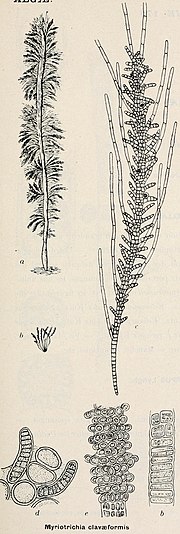| Myriotrichia | |
|---|---|

| |
| Illustration of Myriotrichia clavaeformis | |
| Scientific classification | |
| Domain: | Eukaryota |
| Clade: | Diaphoretickes |
| Clade: | SAR |
| Clade: | Stramenopiles |
| Phylum: | Gyrista |
| Subphylum: | Ochrophytina |
| Class: | Phaeophyceae |
| Order: | Ectocarpales |
| Family: | Chordariaceae |
| Genus: | Myriotrichia Harvey, 1834 |
| Type species | |
| Myriotrichia clavaeformis | |
| Species[2] | |
Myriotrichia is a genus of brown algae.[3]
It forms small, soft, olive-brown tufts on the surface of other plants. Filaments rarely exceed centimetres in length.[4]: 105
It may grow by intercalary growth.[4]: 105 Its sporangia may contain one or many cavities, and emerge directly from the surface cells; they may form a ring around the main nema.[4]: 105 Dedicated photosynthetic machinery may be entirely absent.[4]: 107
Its life history consists of alternation of phases; it has isogamous gametes, and dioecious gametophytes.[5]
At warm temperatures 18 °C (64 °F), the alga reproduces sexually, forming single chambered "meiosporangia". At cooler temperatures, asexual reproduction took place in multi-chambered "mitosporangia".[5]
The gametophyte phase only produces gametes when day length is long; with shorter days these too reproduce asexually.[5] This is probably because the plants upon which they are epiphytic only grow in the spring.[6] The gametophyte is filamentous – while the sporophyte bears parenchyma, even though it only reaches around 4 cm (2 in) in length.[5]
The alga has a small genome with approximately 12 chromosomes.[5]
- ^ a b c d e http://nomen.at/Myriotrichia Myriotrichia – Nomen.at – animals and plants
- ^ M.D. Guiry in Guiry, M.D. & Guiry, G.M. 2018. AlgaeBase. World-wide electronic publication, National University of Ireland, Galway. http://www.algaebase.org/search/genus/detail/?genus_id=w15ed2b43fc747fca ; searched on 30 July 2018.
- ^ Oltmanns, Freidrich (1904). Morphologie und biologie der Algen (in German). Vol. 1. Asher. ISBN 978-1-332-45686-4.
- ^ a b c d F. E. Fritsch (1945). The Structure and Reproduction of the Algae. Vol. II. Cambridge, England: Cambridge University Press.
- ^ a b c d e Peters, Akira F.; Marie, Dominique; Scornet, Delphine; Kloareg, Bernard; Mark Cock, J. (2004). "Proposal Of Ectocarpus Siliculosus (Ectocarpales, Phaeophyceae) As A Model Organism For Brown Algal Genetics And Genomics1,2". Journal of Phycology. 40 (6): 1079. doi:10.1111/j.1529-8817.2004.04058.x. S2CID 86664046.
- ^ Peters, Akira (1992). "Culture studies on the life history of Dictyosiphon hirsutus (Dictyosiphonales, Phaeophyceae) from South America". European Journal of Phycology. 27 (2): 177–183. doi:10.1080/00071619200650181.